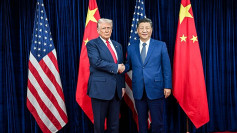China halted its purchases of American soybeans after the trade war with the United States worsened. Concerns are growing that the Asian economic giant might use its U.S. soybean import aw a weapon in the escalating trade war.
According to sources, state-grain buyers haven't received additional orders from China and they are not expecting any because of the lack of agreement in trade negotiations between the two largest economies. The same sources assured that China no plans to cancel previous purchases of American soybeans.
China and the United States exchanged additional tariffs on each other's exports earlier this Month. The trade friction escalated after the United States raised tariffs from 10 to 25 percent on about $200 billion of Chinese goods, causing China to impose additional duties on American goods. Hopes are high that the two leaders might agree on a resolution during their meeting at the end of June for the G-20 summit.
Earlier this month, soybean futures in Chicago fell to a 10-year low caused by the growing trade tension. China purchased about 13 million metric tons of soybeans from the United States during the agreed truce in December, showing goodwill toward getting the trade dispute resolved. In February, U.S. Agriculture Secretary Sonny Perdue said that the Asian nation plans to purchase an additional 10 million tons of American soy.
According to analysts, American soybean farmers are the biggest losers with the trade war in full swing. The United States is the second largest exporter of soybean following Brazil. The United States accounts for $21.4 billion worth of global soybean exports. China purchased two-thirds of the total global soybean imports in 2017, at $39.6 billion. Exports of the United States made up about a third of the total Chinese imports, at $13.9 billion. Soybean is the second-most valuable export of the United States to China following airplanes.
According to Ian Sheldon, Chair in Agricultural Marketing, Trade, and Policy in the Ohio State University, the tariffs have tremendous potential to hurt farmers in the state of Ohio, where soybeans were the number one agricultural export in 2017 at $1.3 billion. China is the largest export market of the state Ohio.
Mr. Sheldon also said that not only do farmers stand to lose out by giving up market share to Brazilian farmers, but soybean prices at the port of New Orleans have fallen as well and are currently $9.35 a bushel compared with $10.82 per bushel a year ago.






